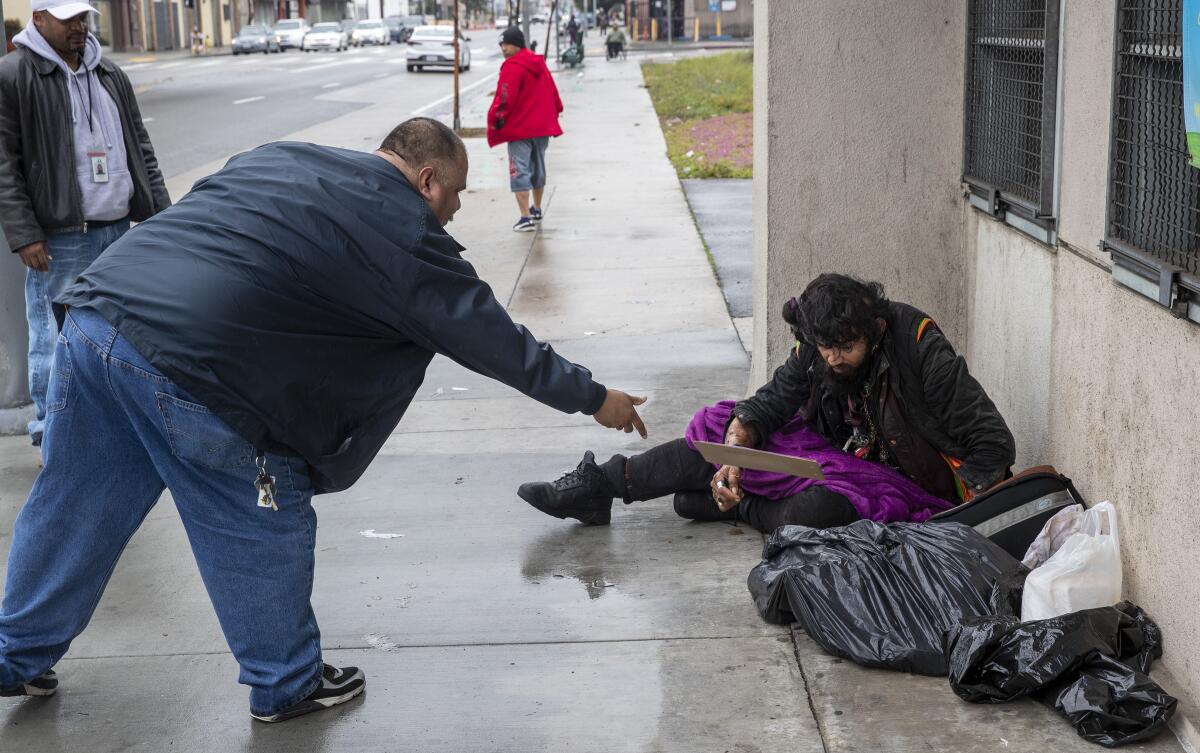Editorial: L.A.’s homeless numbers are up. Again. They’ll go up even more if we don’t act now

The results of the 2020 annual count of homeless people in Los Angeles are grim — and, perhaps, not surprising to any of us who witness daily the tragedy of people living on sidewalks. Homelessness increased by 12.7% in the county, to 66,433, and by 14.2% in the city of Los Angeles, where the number stands at 41,290. The homeless population has now increased by a double-digit percentage for two years in a row.
And that’s despite a record 22,769 homeless people getting off the streets and into housing last year. The maddening reality highlighted by the Los Angeles Homeless Services Authority’s survey is that, despite billions of dollars of investment in housing, shelter and services, we still can’t house people as fast as they fall into homelessness.
In short, this problem will just keep getting worse until local officials stop people from falling into homelessness in the first place. But the task is complicated by a stultifying mix of problems: Institutional racism propels Black people into homelessness at a grossly disproportionate rate. There is a gaping mismatch between incomes and rental prices across the county. Rent is simply unaffordable.
The percentage of homeless people with a serious mental illness remained at 25%. What most newly homeless people suffer from is a severe economic hardship.
And as staggering as the latest numbers are, they could get worse in the wake of the economic devastation wrought by the COVID-19 pandemic — unless the city and county aggressively and unflinchingly protect renters. In a just released study, retired UCLA law professor Gary Blasi predicts an avalanche of evictions that could result in 36,000 homeless households if protections are not put in place.
The county can’t rely on the patchwork of eviction moratoriums imposed during the state of emergency; many renters will continue to face financial hardships long after the emergency is lifted. A state bill would extend the moratoriums while allowing payment plans for renters; the Legislature should approve it. There should also be federal assistance for renters and landlords hurt by the pandemic-induced recession.
The city and the county need to increase the amount of rental subsidies available to keep people from becoming homeless and to help newly homeless return to housing. Sometimes, people need only rental assistance to climb out of homelessness when it’s a ditch they stumbled into and not a sinkhole they are trapped in for years. The city is moving in that direction; Mayor Eric Garcetti said Thursday that he and City Council President Nury Martinez had agreed to set aside $100 million in rental assistance for city residents.
Nothing has so thwarted the effort to get homeless people off the streets of Los Angeles like the lack of permanent housing for homeless people. The $1.2-billion homeless housing program that city voters agreed to nearly four years ago has yielded less than 100 rental units — though thousands are expected to open in the coming years. All told, the city has opened fewer than 750 units of homeless housing in the past fiscal year.
That’s obviously a sliver of what we need now. It’s imperative that the city and county produce innovative, faster-to-build housing — such as modular housing and so-called tiny houses — as well as more temporary housing and shelter for homeless people. Existing buildings that the city, county or state own should be scouted to see if they can be converted into housing.
The real progress that the city and county have made in sheltering homeless people is what they accomplished, remarkably, in just the past three months. About 6,000 particularly vulnerable homeless people have been housed mostly in hotels and motels throughout the county (subsidized heavily by federal emergency aid through a program called Project Roomkey), but also in city recreation centers converted into shelters. That was done to protect homeless people from getting COVID-19. But when the emergency is over and most of those hotels and motels want their rooms back, the city and county must make sure the people now in them aren’t tossed right back onto the streets.
It will be a challenge. The city and the county need to pursue either buying or leasing for the long term some of those motels. That will take some effort and an enormous amount of funding. Philanthropic foundations should be enlisted to help invest in housing of all kind.
No one should give up on permanent housing for homeless people. But as the latest homeless count shows, we also have to do a far better job of keeping people in the homes they have.
More to Read
A cure for the common opinion
Get thought-provoking perspectives with our weekly newsletter.
You may occasionally receive promotional content from the Los Angeles Times.










